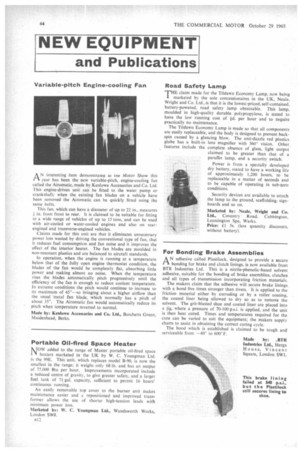NEW EQUIPMENT
Page 46

If you've noticed an error in this article please click here to report it so we can fix it.
and Publications
Variable-pitch Engine-cooling Fan AN interesting item dernonstraten at toe Motor Show this year has been the new variable-pitch, engine-cooling fan called the Airomatic, made by Kenlowe Accessories and Co. Ltd. This engine-driven unit can be fitted to the water pump or crankshaft; when the existing fan blades on a vehicle have been removed the Airomatic can be quickly fitted using the same bolts.
This fan, which can have a diameter of up to 22 in_ measures ; in. from front to rear. It is claimed to be suitable for fitting to a wide range of vehicles of up to 15 tons, and can be used with air-cooled or water-cooled engines and also on rearengined and transverse-engined vehicles.
Claims made for this unit are that it eliminates unnecessary power loss wasted by driving the conventional type of fan, that it reduces fuel consumption and fan noise and it improves the effect of the interior heater. The fan blades are moulded in non-resonant plastics and are balanced to aircraft standards.
In operation, when the engine is running at a temperature below that of the fully open engine thermostat condition, the blades of the fan would be completely flat, absorbing little power and making almost no noise. When the temperature rises the blades automatically pitch progressively until the efficiency of the fan is enough to reduce coolant temperature. In extreme conditions the pitch would continue to increase to its maximum of 45°—so bringing about a higher airflow than the usual 'metal fan blade, which normally has a pitch of about 35°. The Airomatic fan would automatically reduce its pitch when temperature reverted to normal.
Made by: Kenlowe Accessories and Co. Ltd., Burchetts Green, Maidenhead, Berks.
Portable Oil-fired Space Heater NOW added to the range of Master portable oil-fired space heaters marketed in the UK by W. C. Youngman Ltd. is the 99E. This unit, which replaces model B-90, is now the smallest in the range; it weighs only 68 lb. and has an output of 75,000 Btu per hour. Improvements incorporated include a reduced centre of gravity, to give greater safety, and a larger fuel tank of 7-1 gal. capacity, sufficient to permit 16 hours' continuous running.
An easily removable top cover to the burner unit makes maintenance easier and a repositioned and improved transformer allows the use of shorter high-tension leads with minimum power loss.
Marketed by: W. C. Youngman Ltd., Wandsworth Works, London SWg.
RP
Road Safety Lamp THE claim made for the Tildawn Economy Lamp, now being marketed by the sole concessionaires in the UK, Neale. Wright and Co. Ltd., is that it is the lowest-priced, self-contained, battery-powered, road safety lamp obtainable. This lamp, moulded in high-quality durable polypropylene, is stated to have the low running cost of id. per hour and to require practically no maintenance.
The Tildawn Economy Lamp is made so that all components are easily replaceable, and the body is designed to prevent backspin caused by a glancing blow. The anti-dazzle red plastics globe has a built-in lens magnifier with 360° vision. Other features include the complete absence of glass, light output claimed to be greater than that of a paraffin lamp, and a security switch.
Power is from a specially developed dry battery. stated to have a working life of approximately 1.200 hours, to be replaceable in a matter of seconds and to be capable of operating in sub-zero conditions.
Security devices are available to attach the lamp to the ground, scaffolding, signboards and so on.
Marketed by: Neale, Wright and Co. Ltd., Coventry Road. Cubbington. Leamington Spa, Warks.
Price: LI 5s. (less quantity discounts. without battery).
For Bonding Brake Assemblies AN adhesive called Plastilock, designed to provide a secure bonding for brake and clutch linings, is now available from BTR Industries Ltd. This is a nitrile-phenolic-based solvent adhesive, suitable for the bonding of brake assemblies, clutches and all types of transmission incorporating friction materials.
The makers claim that the adhesive will secure brake linings with a bond five times stronger than rivets. It is applied to the friction material either by extruding or by a roller coating, the coated liner being allowed to dry so as to remove the solvent. The grit-blasted shoe and coated liner are placed into a jig, where a pressure of 70-100 p.s.i. is applied, and the unit is then heat cured. Times and temperatures required for the cure can be varied to suit the equipment; the makers supply charts to assist in obtaining the correct curing cycle.
The bond which is established is claimed to be tough and serviceable from —40° to 600°F.
Made by: .BTR Industries Ltd., Herga House, Vincent Square, London SW1.




















































































































